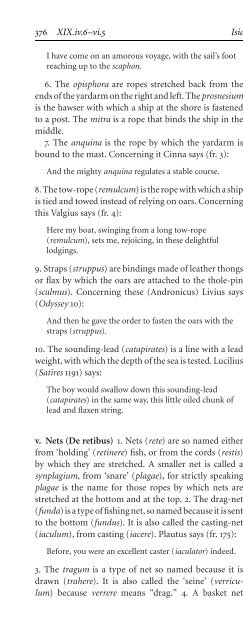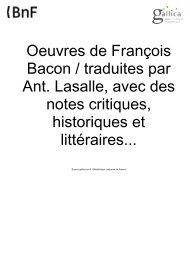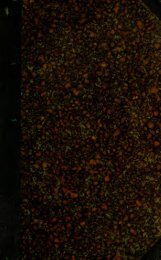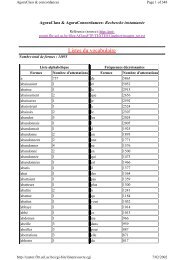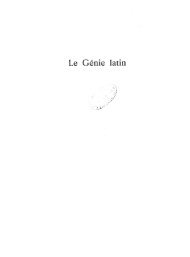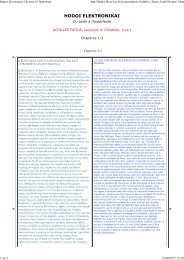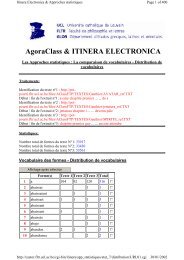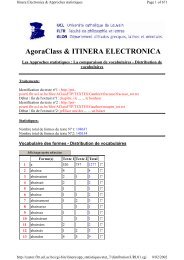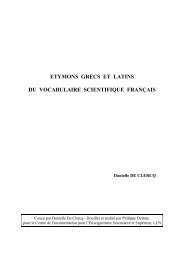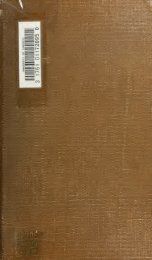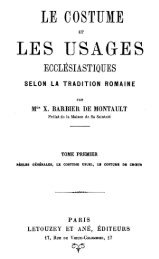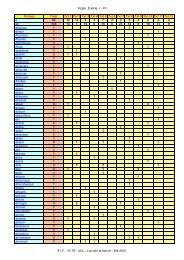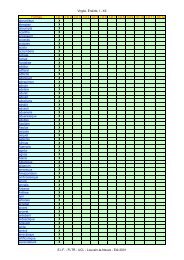The Etymologies of Isidore of Seville - Pot-pourri
The Etymologies of Isidore of Seville - Pot-pourri
The Etymologies of Isidore of Seville - Pot-pourri
You also want an ePaper? Increase the reach of your titles
YUMPU automatically turns print PDFs into web optimized ePapers that Google loves.
376 XIX.iv.6–vi.5 <strong>Isidore</strong> <strong>of</strong> <strong>Seville</strong><br />
Ihave come on an amorous voyage, with the sail’s foot<br />
reaching up to the scaphon.<br />
6. <strong>The</strong>opisphora are ropes stretched back from the<br />
ends <strong>of</strong> the yardarm on the right and left. <strong>The</strong> prosnesium<br />
is the hawser with which a ship at the shore is fastened<br />
to apost. <strong>The</strong> mitra is a rope thatbindstheship in the<br />
middle.<br />
7. <strong>The</strong>anquina is the rope by which the yardarm is<br />
bound to the mast. Concerning it Cinna says (fr. 3):<br />
And the mighty anquina regulates a stable course.<br />
8.<strong>The</strong>tow-rope (remulcum)isthe rope with which a ship<br />
is tied and towed instead <strong>of</strong> relying on oars. Concerning<br />
this Valgius says (fr. 4):<br />
Here my boat, swinging from a long tow-rope<br />
(remulcum), sets me, rejoicing, in these delightful<br />
lodgings.<br />
9.Straps (struppus)are bindings made <strong>of</strong> leather thongs<br />
or flax by which the oars are attached to the thole-pin<br />
(scalmus). Concerning these (Andronicus) Livius says<br />
(Odyssey 10):<br />
And then he gave the order to fasten the oars with the<br />
straps (struppus).<br />
10. <strong>The</strong> sounding-lead (catapirates) isalinewithalead<br />
weight, with which the depth <strong>of</strong> the sea is tested. Lucilius<br />
(Satires 1191)says:<br />
<strong>The</strong> boy would swallow down this sounding-lead<br />
(catapirates) inthe same way, this little oiled chunk <strong>of</strong><br />
lead and flaxen string.<br />
v. Nets (De retibus) 1. Nets(rete) are so named either<br />
from ‘holding’ (retinere) fish, or from the cords (restis)<br />
by which they are stretched. A smaller net is called a<br />
synplagium, from‘snare’ (plagae), for strictly speaking<br />
plagae is the name for those ropes by which nets are<br />
stretched at the bottom and at the top. 2. <strong>The</strong> drag-net<br />
(funda)isatype<strong>of</strong>fishing net, so named because it is sent<br />
to the bottom (fundus). It is also called the casting-net<br />
(iaculum), from casting (iacere). Plautus says (fr. 175):<br />
Before, you were an excellent caster (iaculator) indeed.<br />
3. <strong>The</strong>tragum is a type <strong>of</strong> net so named because it is<br />
drawn (trahere). It is also called the ‘seine’ (verriculum)<br />
because verrere means “drag.” 4. A basket net<br />
(nassa) ... <strong>The</strong>hunting-net (cassis, i.e. casses) isatype<br />
<strong>of</strong> net used by hunters, so named because it captures<br />
(capere). Hence we have the term ‘in vain’ (incassum),<br />
that is, without purpose, as if the term were sine cassibus<br />
(“without hunting-nets”), since without them hunting<br />
is pointless. 5. Mosquito-netting (conopium; cf.<br />
,from,“gnat”) is a net like a tent, by which<br />
gnats are kept out. <strong>The</strong>y are especially used in Alexandria,<br />
because gnats are copiously produced there by the<br />
Nile. Whence it is called conopeum,forEgyptisknownas<br />
Canopea.<br />
vi. <strong>The</strong> metalworkers’ forge (De fabrorum fornace)<br />
1. <strong>The</strong> metalworker (faber) has this name assigned to<br />
him from ‘working iron’ (facere ferrum). From this, the<br />
term was extended to the craftsmen <strong>of</strong> other industrial<br />
materials, and to their workshops (fabrica), but with<br />
amodifier, as in the ‘wood craftsman’ and the rest,<br />
because <strong>of</strong> the solidity (firmitas), as it were, <strong>of</strong> their<br />
products.<br />
2. <strong>The</strong>pagans say that it is Vulcan who has authoring<br />
over the metalworkers’ forge, by Vulcan figuratively<br />
meaning “fire,” as no kind <strong>of</strong> metal can be poured or<br />
stretched without fire. <strong>The</strong>re is almost nothing that cannot<br />
be accomplished with fire, for here it prepares glass,<br />
there silver, here lead, there cinnabar, here pigment, there<br />
medicines. With fire stones are melted into bronze, with<br />
fire iron is produced and tamed, with fire gold is fashioned,<br />
and concrete and walls are bonded by stone that<br />
has been burned with fire. 3. Firewhitensblackstones<br />
when it heats them, and darkens white woods by burning<br />
them. It makes black charcoal from glowing coals,<br />
and fragile objects from hard pieces <strong>of</strong> wood. It creates<br />
incorruptible objects from those that are corruptible. It<br />
loosens what is bound, it binds back what has been loosened.<br />
It s<strong>of</strong>tens what is hard and renders hard what is<br />
s<strong>of</strong>t. It has a medicinal use as well, for it is <strong>of</strong>ten beneficial<br />
to be burnt (i.e. cauterized). It is also a sure aid against<br />
the plague that is contracted when the sun is obscured.<br />
In any sort<strong>of</strong>work,onesubstanceis produced with the<br />
first firing, another with the second, and another with<br />
the third. 4. Fire also has another variation, for there is<br />
one fire that is for human use and another which appears<br />
as a part <strong>of</strong> divine judgment, whether contracting as a<br />
lightning-bolt from the sky or bursting forth from the<br />
earth through the mountain peaks. 5. Fire(ignis) isso<br />
named because nothing can be born (gignere) fromit,


